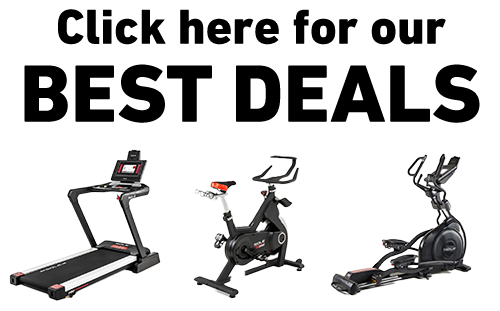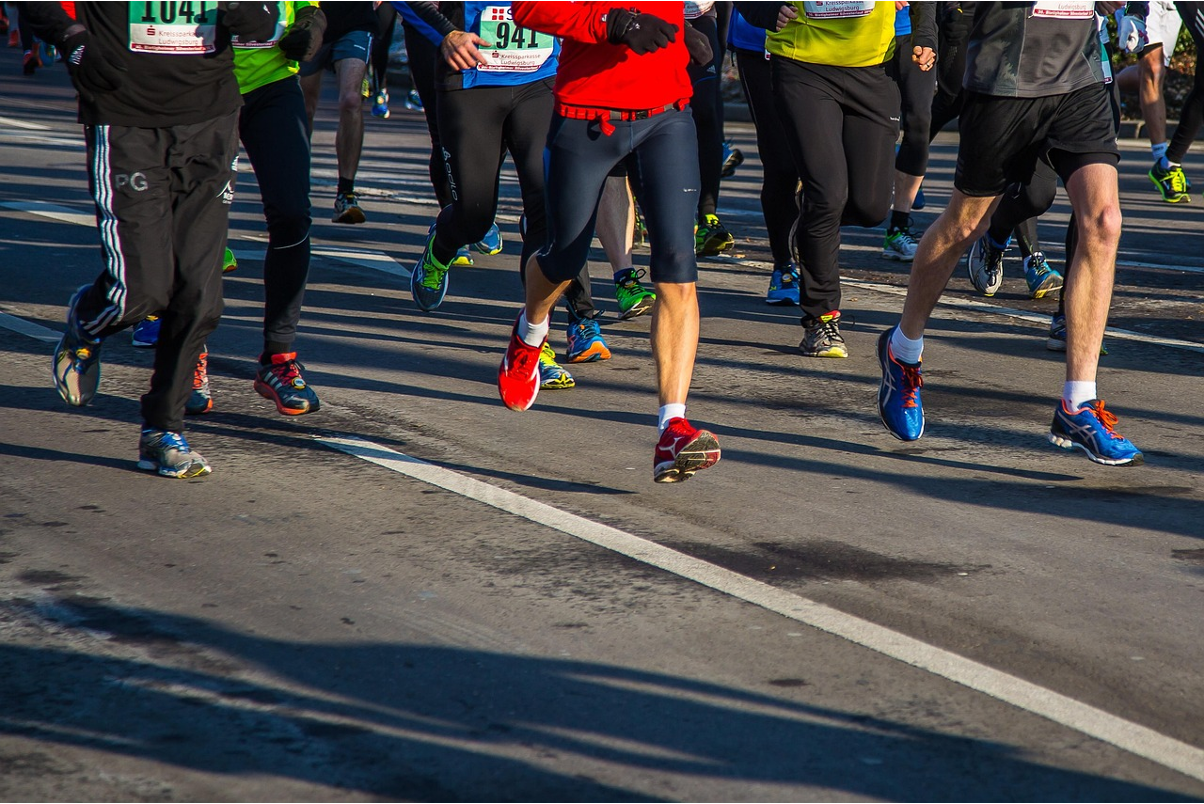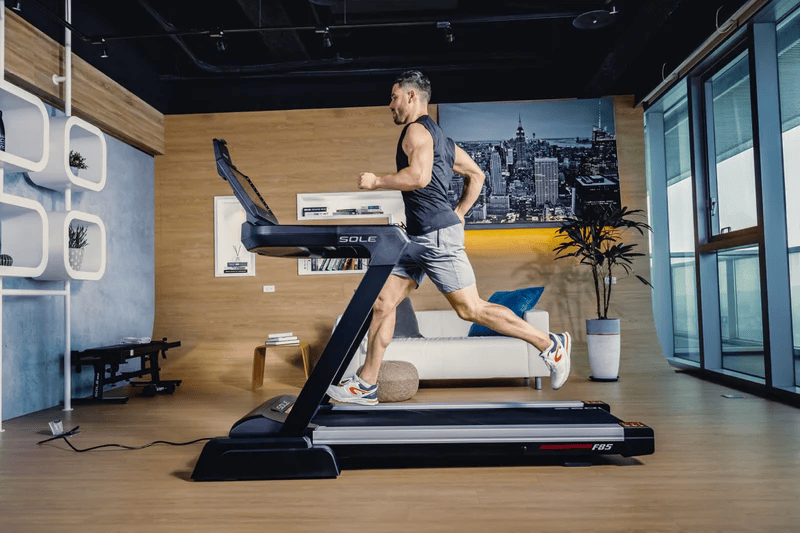Key Takeaways
- Achieving veiny calves requires low body fat (12–15% for men, 18–22% for women), targeted muscle development, and proper hydration that increases blood volume and vein prominence.
- Calf raises, jump rope, and hill sprints are the three most effective exercises for developing visible veins.
- Genetics influence vein placement and skin thickness, but strategic training with progressive overload can enhance natural vascularity potential for almost everyone.
- Train calves 2–3 times weekly for 8–12 weeks minimum to see noticeable improvements, using progressive overload principles that gradually increase weight, volume, or decrease rest periods.
- SOLE's treadmill lineup with 15 levels of incline (0–15%) provides the perfect platform for hill sprint training that maximizes calf activation, while the Equipment Mat supports proper form during calf raises.
Veiny Calves: The Badge of Honor Among Fitness Enthusiasts
Veiny calves aren't just visually impressive; they're a badge of honor among fitness enthusiasts, signaling dedication to training and low body fat levels.
Vascularity, the visibility of veins beneath the skin, occurs when veins are pushed closer to the surface due to increased blood flow and muscle development. During exercise, your body pumps more blood to working muscles, causing veins to expand and become more prominent.
This physiological response is perfectly normal and indicates an efficient cardiovascular system working to deliver oxygen and nutrients to hard-working muscles.
If you're a bodybuilder preparing for competition or simply want more defined lower legs, the path to vascular calves involves specific training approaches that maximize both muscle development and vein visibility.
|
Premium Home Gym Equipment with Award-Winning Quality! Complete Your Home Gym:
Why Choose SOLE: ✓ Commercial-grade quality for home use 30-Day Money-Back Guarantee: Love it or return it, no questions asked. |
Calf Raises: The King of Calf-Building Exercises

Calf raises directly target both heads of the gastrocnemius and the underlying soleus muscle, creating the muscular development necessary to push veins closer to the skin surface.
Standing Calf Raises for Maximum Muscle Growth
Standing calf raises primarily target the gastrocnemius, the diamond-shaped muscle that forms the bulk of your visible calf. For maximum development, perform this exercise with your knees locked straight.
Begin by standing on the edge of a step or platform with your heels hanging off, then rise onto your tiptoes as high as possible, squeezing at the top for 1–2 seconds. Lower slowly to a full stretch, feeling the tension throughout your calf muscles.
For optimal vascularity gains, incorporate both heavy loaded sets (8–10 reps) and lighter, high-rep burnout sets (15–25 reps). This combination promotes both muscle fiber growth and enhanced blood vessel development.
The pump effect from higher-rep work is particularly effective for temporarily increasing vein visibility during and immediately after workouts, while the heavier work builds the long-term muscle development that pushes veins closer to the surface.
A proper mat provides stable, cushioned footing for standing calf raises, protecting your joints during high-volume training while ensuring proper form throughout extended sets.
Seated Calf Raises to Target the Soleus Muscle
The often-neglected soleus muscle lies underneath the gastrocnemius and contributes significantly to complete calf development. Unlike the gastrocnemius, the soleus is best targeted with bent knees.
Seated calf raises are ideal for this purpose; sit on a bench with a weight on your knees, feet flat on the floor, then raise your heels as high as possible while keeping your toes grounded.
The soleus contains a higher percentage of slow-twitch muscle fibers, making it responsive to higher rep ranges of 15–25 repetitions. Training this deeper muscle creates the full, three-dimensional calf development that pushes surface veins outward. Many trainees with stubborn calves find that dedicated soleus work becomes the missing piece in their vascularity puzzle.
Single-Leg Variations for Balanced Development
Single-leg calf raises correct muscular imbalances that can limit overall development. Most people have one dominant leg that takes over during bilateral exercises, leading to asymmetrical development.
By training each leg independently, you ensure that both calves develop equally, creating balanced vascularity throughout both legs.
Jump Rope: The Cardiovascular Approach to Vascular Calves

Jump rope training combines hundreds of calf contractions with cardiovascular stimulus that reduces body fat while enhancing blood flow.
Why Jump Rope Creates Incredible Calf Definition
Jump rope training creates exceptional calf definition through constant dynamic contraction of the gastrocnemius and soleus muscles.
With each jump, your calves must generate enough force to propel your body weight off the ground while simultaneously controlling your landing. This combination of concentric and eccentric stress creates the perfect environment for muscle development and vascular enhancement.
The continuous nature of jumping rope increases blood flow to the lower extremities, temporarily expanding veins and capillaries.
Regular sessions create what exercise physiologists call "vascular adaptation"—the permanent expansion of blood vessels to accommodate increased circulatory demands. This adaptation is precisely what creates the rope-like veins prized by bodybuilders and fitness enthusiasts.
Unlike weight training alone, jump rope sessions elevate your heart rate into the fat-burning zone, helping reduce the subcutaneous fat that obscures vein definition.
HIIT Jump Rope Protocols for Vein-Popping Results
High-Intensity Interval Training with a jump rope maximizes both the cardiovascular and muscular benefits of this exercise. Rather than steady-state jumping, alternate between periods of maximum-effort jumping and brief recovery periods.
This approach triggers greater physiological adaptations while preventing the efficiency plateaus common with steady-state cardio.
Begin with a basic protocol: 20 seconds of maximum-effort jumping followed by 40 seconds of rest, repeated for 8–10 rounds. As your conditioning improves, gradually increase work periods and decrease rest periods.
Advanced athletes might work up to 40-second jump intervals with just 20 seconds of recovery. The intense metabolic demand of these protocols accelerates fat loss while creating the intramuscular pressure necessary for vein prominence.
Proper Technique to Maximize Calf Engagement
To maximize calf activation during jump rope sessions, focus on jumping primarily from the balls of your feet rather than flat-footed jumping.
This technique concentrates tension on the gastrocnemius and soleus while minimizing impact on your joints. Keep jumps low, just high enough for the rope to pass under your feet, which forces your calves to generate rapid, repeated contractions that stimulate vascular development.
Vary your jumping style throughout the workout to target different areas of the calf complex. Single-leg jumps, high knees, double unders, and crossovers each shift emphasis to different portions of the calf muscles. This variation prevents adaptation while ensuring no part of the calf complex is neglected.
Hill Sprints: Explosive Power

Hill sprints combine explosive power, high resistance, and cardiovascular intensity to create unparalleled stimulus for lower leg development and visible vascularity.
How Sprinting Uphill Forces Maximum Calf Activation
Uphill sprinting forces your body to overcome both gravity and distance, creating intense mechanical tension throughout the calf complex.
Unlike flat-ground running where momentum carries you forward, hill sprints require continuous power generation from the posterior chain, with the calves serving as the primary propulsive force. This increased workload triggers rapid adaptations in both muscle tissue and vascular structures.
The biomechanics of hill sprinting naturally shift your weight toward the forefoot, concentrating tension precisely where it's needed for maximum calf development. This targets both the gastrocnemius and soleus muscles simultaneously, creating balanced development throughout the entire calf region. The resulting muscle growth pushes superficial veins closer to the skin surface, enhancing visibility even at rest.
Finding the Right Incline for Your Fitness Level
The optimal hill gradient for calf development falls between 15-30 degrees, with beginners starting at the lower end of this range. Too shallow an incline fails to create sufficient overload, while excessive steepness can alter running mechanics and increase injury risk.
Begin with a moderate incline that challenges you without compromising your sprinting form, then gradually progress to steeper angles as your fitness improves.
Recovery Periods: The Secret to Sprint Effectiveness
The recovery interval between hill sprints is crucial for both performance and results. Complete recovery allows maximum effort on each sprint, ensuring you generate enough force to stimulate calf development. For most trainees, a work-to-rest ratio of 1:3 or 1:4 provides optimal results, meaning a 10-second sprint would be followed by 30-40 seconds of recovery. Walking during recovery between sprints serves as active recovery, allowing heart rate to decrease while maintaining blood flow to the lower extremities.
Build Veiny Calves with SOLE's Complete System

SOLE's comprehensive equipment lineup provides everything needed for maximum calf vascularity development.
The SOLE Equipment Mat provides the essential cushioned foundation for calf raise variations that build the muscle necessary to push veins closer to the skin surface.
The superior cushioning protects joints during standing calf raises with heavy loads, supports proper form during high-rep burnout sets of 15–25 repetitions that create the pump effect, and creates stable footing for single-leg variations that ensure balanced development.
The professional-grade thickness allows extended calf training sessions without joint discomfort, while the non-slip surface prevents sliding during explosive calf movements.
For hill sprint training that forces maximum calf activation, SOLE's treadmill lineup delivers commercial-grade performance with joint-protective technology. The F63 Treadmill provides accessible entry to structured hill training with 15 levels of incline (0–15%).
The F80 Treadmill adds a 10.1" touchscreen and 3.25 HP motor for enhanced programming and performance, while the F85 and F89 models deliver even more power with 3.5 HP and 4.0 HP motors respectively, plus premium features for serious runners.
The ST90 Treadmill offers premium slat belt technology for athletes seeking the ultimate running experience, while the TT8 Treadmill provides commercial-grade non-folding construction for dedicated training spaces.
The SW180 Adjustable Dumbbells enable loaded calf raises with 16 weight options from 5–80 pounds, providing the progressive resistance necessary for continuous muscle development.
The free SOLE+ App delivers structured calf development programs with progressive overload protocols, guided hill sprint sessions with proper work-to-rest ratios, and jump rope HIIT protocols for cardiovascular conditioning.
Check out SOLE's complete collection today!
Frequently Asked Questions (FAQs)
Can everyone achieve visible veins in their calves?
While everyone can improve their calf vascularity to some degree, genetic factors significantly influence your maximum potential. Vein placement, skin thickness, and natural fat distribution patterns are largely hereditary and create different baselines between individuals. Those with naturally thin skin and superficial veins will display vascularity at higher body fat percentages, while others may need to reach extremely low body fat levels to achieve similar visibility.
How long does it take to develop veiny calves?
Visible improvements in calf vascularity typically emerge within 8–12 weeks of consistent training, assuming proper nutrition and progressive overload principles are followed. Initial changes include temporary pumps during and immediately after workouts, with permanent vascularity developing gradually as body fat decreases and muscle development increases. Those starting with higher body fat percentages may need to focus on fat loss for several months before significant vascularity becomes apparent, regardless of training volume.
Should I train calves every day for better vascularity?
Despite their reputation for being stubborn, calves respond better to appropriate recovery than daily training. For most individuals, training calves 2–3 times weekly with high intensity provides optimal results while allowing sufficient recovery between sessions. Daily training often leads to diminished returns due to inadequate recovery time, potentially causing overtraining symptoms and reduced vascularity development.
Does massage help improve calf vascularity?
Strategic massage techniques can temporarily enhance vein visibility by increasing blood flow to the area and reducing excess fluid retention. Deep tissue massage breaks down fascial restrictions that may impede superficial circulation, potentially enhancing long-term vascular visibility. For temporary enhancement before photoshoots or competitions, many bodybuilders utilize firm massage with warming oils to bring superficial veins to the surface.
How does SOLE equipment support comprehensive calf development and vascularity training?
SOLE equipment provides the complete foundation for maximizing calf vascularity through targeted muscle building, cardiovascular conditioning, and progressive training protocols.
The Equipment Mat is essential for calf raise variations, offering superior cushioning for standing calf raises that protects joints during heavy loaded sets and high-rep burnout work, providing stable footing for single-leg variations that correct muscular imbalances, and creating a non-slip surface for bodyweight calf exercises performed during circuit training or finisher sets.
Most importantly, SOLE's comprehensive treadmill lineup featuring Cushion Flex technology provides the perfect platform for hill sprint training that maximizes calf activation.




Leave a comment
This site is protected by hCaptcha and the hCaptcha Privacy Policy and Terms of Service apply.